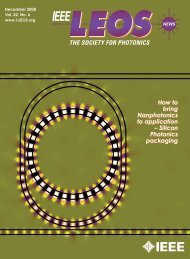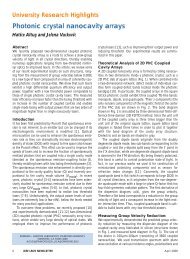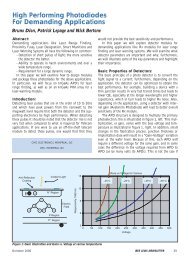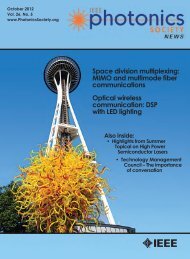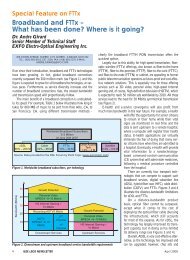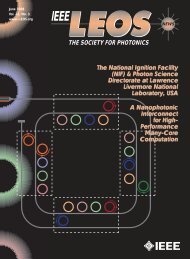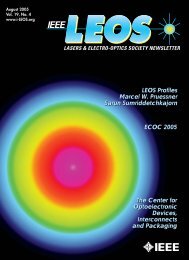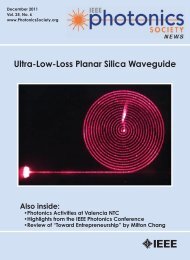Photonics Work at Lawrence Livermore National Laboratory, USA
Photonics Work at Lawrence Livermore National Laboratory, USA
Photonics Work at Lawrence Livermore National Laboratory, USA
Create successful ePaper yourself
Turn your PDF publications into a flip-book with our unique Google optimized e-Paper software.
Research Highlights<strong>Photonics</strong> <strong>Work</strong> <strong>at</strong><strong>Lawrence</strong> <strong>Livermore</strong> N<strong>at</strong>ional Labor<strong>at</strong>oryTony Ladran, Deputy of Oper<strong>at</strong>ions, Photon Science and Applic<strong>at</strong>ions Program,<strong>Lawrence</strong> <strong>Livermore</strong> N<strong>at</strong>ional Labor<strong>at</strong>oryTHIS WORK PERFORMED UNDER THE AUSPICES OF THE U.S.DEPARTMENT OF ENERGY BY LAWRENCE LIVERMORE NATIONALLABORATORY UNDER CONTRACT DE-AC52-07NA27344The N<strong>at</strong>ional Ignition Facility (NIF) & PhotonScience Director<strong>at</strong>e <strong>at</strong> <strong>Lawrence</strong> <strong>Livermore</strong> N<strong>at</strong>ionalLabor<strong>at</strong>ory comprises five programs, each focused on oneor more aspects of NIF's missions. They are:N<strong>at</strong>ional Ignition FacilityThe N<strong>at</strong>ional Ignition Facility Project isresponsible for the construction and oper<strong>at</strong>ionof NIF, a 192-beam experimental laserfacility. This unique facility is the world'slargest and highest-energy laser, capable of cre<strong>at</strong>ing temper<strong>at</strong>uresand pressures similar to those th<strong>at</strong> exist only in thecores of stars and giant planets and inside nuclear weapons.N<strong>at</strong>ional Ignition CampaignThe N<strong>at</strong>ional Ignition Campaign (NIC)encompasses all of the experiments, hardwareand infrastructure needed to carry outthe initial ignition experiments on NIF beginning in2010 and to continue research on ignition in the followingyears. NIC is a key element of the N<strong>at</strong>ional NuclearSecurity Administr<strong>at</strong>ion.Photon Science & Applic<strong>at</strong>ionsThe Photon Science & Applic<strong>at</strong>ions (PS&A)Program provides advanced solid-st<strong>at</strong>e laser andoptics technologies to the labor<strong>at</strong>ory, government, and industry forimportant n<strong>at</strong>ional needs. The primary activities of PS&A inrecent years have been: (1) to complete the laser technology ddevelopment and laser component testing for the U.S.Department of Energy's NIF project, (2) to develop advancedsolid-st<strong>at</strong>e laser systems and optical components for theDepartment of Defense and Department of Energy and (3) toaddress the needs of other government agencies and U.S. industry.Inertial Fusion EnergyThe Inertial Fusion Energy Program isexploring a variety of approaches to usinginertial confinement fusion, NIF's coretechnology to achieve energy gain and helplay the groundwork for the eventual use of fusion energyas a clean, safe, virtually limitless source of electricity.Science <strong>at</strong> the ExtremesNIF will become a premier intern<strong>at</strong>ionalcenter for experimental science early in thenext decade. The extreme temper<strong>at</strong>uresand pressures th<strong>at</strong> will be cre<strong>at</strong>ed insidethe NIF target chamber will enable scientists from aroundthe world to conduct unprecedented experiments in highenergy density science and to gain new insights into suchmysterious astrophysical phenomena as supernovae, giantplanets, and black holes.NIF: The ‘Crown Joule’ of Laser ScienceThe N<strong>at</strong>ional Ignition Facility (NIF) is the world'slargest laser. See Figure 1. NIF's 192 intense laser beamswill deliver to its target more than 60 times the energy ofany previous laser system. When all 192 beams are oper-Figure 1. Three football fields could fit inside the NIF Laser andTarget Area Building.4 IEEE LEOS NEWSLETTER June 2008
Acceler<strong>at</strong>ing the pace of engineering and scienceParlez-vousMATLAB?Over one million people aroundthe world speak MATLAB.Engineers and scientists in everyfield from aerospace andsemiconductors to biotech,financial services, and earth andocean sciences use it to expresstheir ideas.Do you speak MATLAB?Quantit<strong>at</strong>ive highthroughputgene expressionimaging using d<strong>at</strong>afrom FlyEx D<strong>at</strong>abase.This example available <strong>at</strong>m<strong>at</strong>hworks.com/ltc®©2007 The M<strong>at</strong>h<strong>Work</strong>s, Inc.Image from FlyEx D<strong>at</strong>abase. Used by permission. http://flyex.ams.sunysb.edu/flyex and http://urchin.spbcas.ru/flyexThe language of technical computing.
<strong>at</strong>ional in 2009, NIF will direct nearly two million joulesof ultraviolet laser energy in billionth-of-a-second pulsesto the target chamber center.When all th<strong>at</strong> energy slams into millimeter-sized targets,it can gener<strong>at</strong>e unprecedented temper<strong>at</strong>ures andpressures in the target m<strong>at</strong>erials – temper<strong>at</strong>ures of morethan 100 million degrees and pressures more than 100billion times Earth's <strong>at</strong>mosphere. These conditions aresimilar to those in the stars and the cores of giant planetsor in nuclear weapons; thus one of the NIF & PhotonScience Director<strong>at</strong>e's missions is to provide a betterunderstanding of the complex physics of nuclear weapons.Researchers can also explore basic science, such as astrophysicalphenomena, m<strong>at</strong>erials science and nuclear science.NIF's other major mission is to provide scientistswith the physics understanding necessary to cre<strong>at</strong>e fusionignition and energy gain for future energy production.Figure 2. Technicians adjust the target positioner inside the NIFTarget Chamber.A Variety of ExperimentsNot all experiments on NIF need to produce fusion ignition.Researchers are planning many other types of experimentsth<strong>at</strong> will take advantage of NIF's tremendous energyand flexible geometry in non-ignition shots. Non-ignitionexperiments will use a variety of targets to derive abetter understanding of m<strong>at</strong>erial properties under extremeconditions. These targets can be as simple as fl<strong>at</strong> foils orconsiderably more complex. By varying the shock strengthof the laser pulse, scientists can obtain equ<strong>at</strong>ion-of-st<strong>at</strong>ed<strong>at</strong>a th<strong>at</strong> reveal how different m<strong>at</strong>erials perform underextreme conditions for stockpile stewardship and basic science.They also can examine hydrodynamics, which is thebehavior of fluids of unequal density as they mix.NIF experiments also will use some of the beams toillumin<strong>at</strong>e "backlighter" targets to gener<strong>at</strong>e an X-rayflash. This allows detailed X-ray photographs, or radiographs,of the interiors of targets as the experimentsprogress. In addition, moving pictures of targets taken <strong>at</strong>one billion frames a second are possible using sophistic<strong>at</strong>edcameras mounted on the target chamber. These diagnosticscan freeze the motion of extremely hot, highlydynamic m<strong>at</strong>erials to see inside and understand the physicalprocesses taking place As construction of the 48"quads" of four beams each proceeded, many shots werealready being performed using the first quad of beams.Experiments beginning in the winter of 2007-2008 willtake advantage of additional quads as they come online.New Technologies Make NIF PossibleAmplifying NIF's beams to record-sh<strong>at</strong>tering energies,keeping the highly energetic beams focused, maintainingcleanliness all along the beam's p<strong>at</strong>h, and successfullyoper<strong>at</strong>ing this enormously complex facility – all requiredNIF's designers to make major advances in existing lasertechnology as well as to develop entirely new technologies.Innov<strong>at</strong>ions in the design, manufacture, and assemblyof NIF's optics were especially critical.The Seven Wonders of NIFWhile construction of the football-stadium-sizedN<strong>at</strong>ional Ignition Facility was a marvel of engineering,NIF is also a tour de force of science and technologydevelopment. To put NIF on the p<strong>at</strong>h to ignition experimentsin 2010, scientists, engineers and technicians hadto overcome a daunting array of challenges.<strong>Work</strong>ing closely with industrial partners, the NIFteam found solutions for NIF's optics in rapid-growthcrystals, continuous-pour glass, optical co<strong>at</strong>ings and newfinishing techniques th<strong>at</strong> can withstand NIF's extremelyhigh energies. The team also worked with companies todevelop pulsed-power electronics, innov<strong>at</strong>ive control systemsand advanced manufacturing capabilities. Seventechnological breakthroughs in particular were essentialfor NIF to succeed:1.Faster, Less Expensive Laser Glass ProductionLaser glass is the heartof the NIF laser system;it's the m<strong>at</strong>erial th<strong>at</strong>amplifies the laser lightto the very high energiesrequired for experiments.NIF's laserglass is a phosph<strong>at</strong>eglass th<strong>at</strong> contains achemical additive with<strong>at</strong>oms of neodymium.Figure 3. NIF Glass laser slab inproductionThe NIF laser system uses about 3,070 large pl<strong>at</strong>es oflaser glass. Each glass pl<strong>at</strong>e is about three feet long andabout half as wide. If stacked end-to-end, the pl<strong>at</strong>eswould form a continuous ribbon of glass 1.5 miles long.To produce this glass quickly enough to meet constructionschedules, NIF uses a new production method developedin partnership with two companies – HoyaCorpor<strong>at</strong>ion, <strong>USA</strong> and Schott Glass Technologies, Inc. –th<strong>at</strong> continuously melts and pours the glass. See Figure3. Once cooled, the glass is cut into pieces th<strong>at</strong> are polishedto the demanding NIF specific<strong>at</strong>ions.6 IEEE LEOS NEWSLETTER June 2008
2. Large Aperture Optical SwitchesA key element of the amplifier sectionof NIF's laser beamp<strong>at</strong>h is an opticaldevice called a plasma electrode Pockelscell, or PEPC, th<strong>at</strong> contains a pl<strong>at</strong>e ofpotassium dihydrogen phosph<strong>at</strong>e(KDP). See Figure 4. This device, inconcert with a polarizer, acts as a switch– allowing laser beams into the amplifierand then rot<strong>at</strong>ing its polariz<strong>at</strong>ion totrap the laser beams in the amplifiersection. A thin plasma electrode th<strong>at</strong> istransparent to the laser wavelength allows a high electric field tobe placed on the crystal, which causes the polariz<strong>at</strong>ion to rot<strong>at</strong>e.The trapped laser beams can then increase their energy muchmore efficiently using multiple passes back and forth throughthe energized amplifier glass. After the laser beams make fourpasses through the amplifiers, the optical switch rot<strong>at</strong>es theirpolariz<strong>at</strong>ion back to its normal configur<strong>at</strong>ion, letting themspeed along their p<strong>at</strong>h to the target chamber.3. Stable, High-Gain PreamplifiersNIF uses 48 preamplifiermodules, or PAMs,each of which provideslaser energy for fourNIF beams. The PAMreceives a very lowenergy (billionth of ajoule) pulse from themaster oscill<strong>at</strong>or roomand amplifies the pulseby a factor of about amillion, to a millijoule. It then boosts the pulse onceagain to a maximum of about ten joules by passing thebeam four times through a flashlamp-pumped rod amplifier.To perform the range of experiments needed on NIF,the PAMs must perform three kinds of precision sp<strong>at</strong>ial,spectral and temporal shaping of the input laser beams.4. Deformable MirrorsThe deformable mirroris an adaptive optic th<strong>at</strong>uses an array of actu<strong>at</strong>orsto bend its surface tocompens<strong>at</strong>e for wavefronterrors in the NIFlaser beams. There is onedeformable mirror foreach of NIF's 192beams. Advances inadaptive optics in theFigure 4. PlasmaElectrode Pockels CellFigure 5. 10 Joule PreAmpliermoduleFigure 6. 40 cm x 40 cm full aperturedeformable mirror<strong>at</strong>omic vapor laser isotope separ<strong>at</strong>ion (AVLIS) program <strong>at</strong><strong>Lawrence</strong> <strong>Livermore</strong> N<strong>at</strong>ional Labor<strong>at</strong>ory demonstr<strong>at</strong>edth<strong>at</strong> a deformable mirror could meet the NIF performancerequirement <strong>at</strong> a feasible cost. <strong>Livermore</strong> researchers developeda full-aperture (40-centimeter-square) deformablemirror th<strong>at</strong> was installed on the Beamlet laser in early1997. Prototype mirrors from two vendors were also testedin the l<strong>at</strong>e 1990s. The first of NIF's deformable mirrorswere fabric<strong>at</strong>ed, assembled and tested <strong>at</strong> the University ofRochester's Labor<strong>at</strong>ory for Laser Energetics and installedand successfully used on NIF to correct wavefronts for thefirst beams sent to target chamber center.5. Large, Rapid-Growth CrystalsNIF's KDP crystals servetwo functions: frequencyconversion and polariz<strong>at</strong>ionrot<strong>at</strong>ion. The developmentof the technologyto quickly grow highqualitycrystals shown inthis photo, were a majorundertaking and is perhapsthe most highlypublicized technologicalsuccess of the NIF project. NIF laser beams start out asinfrared light, but the interaction of the beams with thefusion target is much more favorable if the beams are ultraviolet.Passing the laser beams through pl<strong>at</strong>es cut from largeKDP crystals converts the frequency of their light to ultravioletbefore they strike the target. The rapid-growth processfor KDP, developed to keep up with NIF's aggressive constructionschedule, is amazingly effective: Crystals th<strong>at</strong> wouldhave taken up to two years to grow by traditional techniquesnow take only two months. In addition, the size of the rapidgrowthcrystals is large enough th<strong>at</strong> more pl<strong>at</strong>es can be cutfrom each crystal, so a smaller number of crystals can provideNIF with the same amount of KDP.6. Target Fabric<strong>at</strong>ionTo meet the needs of NIFexperiments, NIF's millimeter-sizedtargetsmust be designed andfabric<strong>at</strong>ed to meet precisespecific<strong>at</strong>ions for density,concentricity and surfacesmoothness. When a newFigure 7. NIF rapid-growth KDPcrystalFigure 8. Target Assemblym<strong>at</strong>erial structure is needed, m<strong>at</strong>erials scientists cre<strong>at</strong>e thenecessary raw m<strong>at</strong>erials. Fabric<strong>at</strong>ion engineers then determinewhether those m<strong>at</strong>erials – some never seen before – canbe machined and assembled. Manufacturing requirements forall NIF targets are extremely rigid. Components must bemachined to within an accuracy of one micrometer, or onemillionthof a meter. In addition, the extreme temper<strong>at</strong>uresand pressures the targets will encounter during experimentsmake the results highly susceptible to imperfections in fabric<strong>at</strong>ion.Thus, the margin of error for target assembly, whichvaries by component, is strict. Throughout the designprocess, engineers inspect the target m<strong>at</strong>erials and componentsusing nondestructive characteriz<strong>at</strong>ion methods toensure th<strong>at</strong> target specific<strong>at</strong>ions are met and th<strong>at</strong> all componentsare free of defects. Together, this multidisciplinary teamtakes an experimental target from concept to reality.8 IEEE LEOS NEWSLETTER June 2008
7. Integr<strong>at</strong>ed Computer Control SystemFulfilling NIF's promiserequires one of the mostsophistic<strong>at</strong>ed computercontrol systems in governmentservice or priv<strong>at</strong>eindustry. Every NIFexperimental shot requiresFigure 9. NIF Control Roomthe coordin<strong>at</strong>ion of complex laser equipment. In theprocess, some 60,000 control points for electronic, highvoltage, optical and mechanical devices – such as motorizedmirrors and lenses, energy and power sensors, videocameras, laser amplifiers, pulse power and diagnosticinstruments – must be monitored and controlled. SeeFigure 9. The precise orchestr<strong>at</strong>ion of these parts byNIF's integr<strong>at</strong>ed computer control system will result inthe propag<strong>at</strong>ion of 192 separ<strong>at</strong>e nanosecond (billionth ofa second)-long bursts of light over a one-kilometer p<strong>at</strong>hlength. The 192 separ<strong>at</strong>e beams must have optical p<strong>at</strong>hlengthsequal to within nine millimeters so th<strong>at</strong> thepulses can arrive within 30 picoseconds (trillionths of asecond) of each other <strong>at</strong> the center of a target chamberten meters in diameter. Then they must strike within 50micrometers of their assigned spot on a target measuringless than one centimeter long – an accuracy comparableto throwing a pitch over the strike zone from 350miles away.Developing the St<strong>at</strong>e-of-the-artfor N<strong>at</strong>ional SecurityThe Photon Science and Applic<strong>at</strong>ions (PS&A) program pursuesn<strong>at</strong>ional security missions by developing st<strong>at</strong>e-of-the-art opticsand laser technology. Through research and development,PS&A is developing technologies th<strong>at</strong> advance the frontiers ofdiode-pumped laser technology, high-peak power lasers andscience, gener<strong>at</strong>ion and applic<strong>at</strong>ion of bright, high-energy photonsand fabric<strong>at</strong>ion of precision, meter-scale optics.Tailored-Aperture Ceramic LaserTo improve the run time and beam quality of large, highaverage-power(HAP), diode-pumped solid-s<strong>at</strong>e laser(DPSSL) systems, PS&A has developed a new slab laser technologycalled the tailored-aperture ceramic laser (TACL). Ahigher-performance descendent of the solid-st<strong>at</strong>e he<strong>at</strong>-capacityThe TACLLaser (SSHCL) system shown, TACL in Figure10 uses composite ceramic Nd3+:YAG/Sm3+:YAG slabsth<strong>at</strong> are edge pumped.By smoothing the high sp<strong>at</strong>ial frequency pump-deposition ripplesth<strong>at</strong> result from face pumping, edge pumping can improve systembeam quality and runtime considerably. New diode-pumparrays are also employed in TACL th<strong>at</strong> use high-performancemicrolens conditioning and microchannel cooling. The microchannelcooling of the arrays allows the diode packages to be run with ahigh duty cycle – even continuously – while gener<strong>at</strong>ing high averageoptical pump power. As a result, TACL designs can use as litx(−1)Figure 10. Edge pumping is made possible by use of a ceramic Sm3+:YAG frame th<strong>at</strong> is integral to the Nd3+:YAG portion of the slab.Sm3+:YAG absorbs <strong>at</strong> the laser wavelength, but is transparent <strong>at</strong> the pump wavelength. The Sm3+:YAG frame suppresses amplified spontaneousemission without affecting passage of the pump light. This recent development proceeds from the concerted work of LLNL and theKonoshima Chemical Company and promises to revolutionize the design of large HAP laser systems by significantly improving beam quality.10 IEEE LEOS NEWSLETTER June 2008
tle as one-tenth of the diode arrays employed by the SSHCL systemwhile achieving the same power output capability.Solid-St<strong>at</strong>e He<strong>at</strong>-Capacity LaserPS&A is developing a high-average-power (100-kW-class),diode-pumped, solid-st<strong>at</strong>e he<strong>at</strong>-capacity laser (SSHCL) suitable foruse in military weapons. A mobile, compact, and lightweightSSHCL laser system capable of being deployed on a variety of pl<strong>at</strong>formsis also under development. Potential military applic<strong>at</strong>ions ofsuch a system include the targeting and destruction of short-rangerockets, guided missiles, artillery and mortar fire, unmanned aerialvehicles and improvised explosive devices, or IEDs.In 2006, PS&A achieved a major accomplishment when theSSHCL produced 67 kilow<strong>at</strong>ts of power – a 50 percent increase inthe world-record-setting power level achieved the previous year.See Figure 11. This class of power demonstr<strong>at</strong>es th<strong>at</strong> tabletop-sizedsolid-st<strong>at</strong>e lasers have come of age and can fulfill the performancerequirements for their use in tactical weapon applic<strong>at</strong>ions.Additionally, improvements to the SSHCL's laser optics, bothin m<strong>at</strong>erial selection and geometric architecture, have gre<strong>at</strong>lyenhanced temper<strong>at</strong>ure profile uniformity throughout the lasingcavity, yielding a beam quality two times the diffraction limit forfive seconds of run time in PS&A's unstable reson<strong>at</strong>or. See Figure12. Beam quality control is integral to PS&A's laser systemdevelopment, and results like these portend the use of directedenergyweapons on the b<strong>at</strong>tlefield where they can effect "speedof-light"engagement in compact, mobile packages.The extremely high fracture toughness of ceramicYAG:Nd3+, along with its facility for use in composinglarger slabs, makes it the ideal m<strong>at</strong>erial for laser gain media.Output Power (kW)806040200ReducedApertureThreeThree Four FiveNumber of SlabsCalcul<strong>at</strong>edMeasured @10%Duty CycleMeasured @20%Duty CycleFigure 11. The 67 kilow<strong>at</strong>ts of average power was achieved usingfive ceramic neodymium-doped yttrium aluminum garnet(YAG:Nd3+) laser-gain media slabs; model calcul<strong>at</strong>ions were valid<strong>at</strong>edby experimental results as depicted in the graph.Laser-M<strong>at</strong>erial InteractionPS&A's SSHCL test bed has afforded execution of extensivelaser-m<strong>at</strong>erial interaction experiments using a wide varietyof m<strong>at</strong>erials such as steels, aluminums, titaniums andorganic composites. Varying the spot size of the laser beamfrom a few millimeters to a 162-centimeter locus while sustainingan air flow r<strong>at</strong>e of 100 meters per second <strong>at</strong> thepoint of laser-m<strong>at</strong>erial interaction loosely simul<strong>at</strong>es a targetflying in the <strong>at</strong>mosphere. See Figure 13. All tests were conducted<strong>at</strong> the nominal 25 kilow<strong>at</strong>ts of average laser power.June 2008 IEEE LEOS NEWSLETTER 11
These test results reveal the functioning of several mechanismswhen the laser is used to destroy a target: thermalhe<strong>at</strong>ing of the high explosive to ignition; increased m<strong>at</strong>erialremoval due to combustion of certain m<strong>at</strong>erials from the“Times Diffractioon Limited” BeamQuality8765432100Fall 2005Beam QualityFall 2005200 400 600 800 1000Shot Number (200 Shots = 1 Second)BK7 Window, No DiffusersFS Window, with Diffusers, Run #2Fused Silica Window, No Diffusers FS Window, with Diffusers, Run #3FS Window, with Diffusers, Run #1 FS Window, with Diffusers, Run #4Figure 13. SSHCL experimental test setup, using 25-kilow<strong>at</strong>taveragelaser power, 132-cm laser beam spot size, and 100-meterper-secondair flow.Figure 14. Concept of a 100-kW, movable, fully self-containedTACL/SSHCL ready for live target testing.Spring 2006No Diffusers, Power ~12 kW, with Diffusers, Power ! 10 kW, Unstable Reson<strong>at</strong>orFigure 12. A beam quality of two times the diffraction limit – for five seconds – wasachieved on the SSHCL testbed.increased oxygen during air flight; and aerodynamic forcesth<strong>at</strong> literally rip the membrane from the annealed andweakened target, making it aerodynamically unstable.Potential Pl<strong>at</strong>formsThe development of a prototype pl<strong>at</strong>formusing SSHCL TACL technologysuitable for testing <strong>at</strong> a proving groundor test range is the next step in the evolutionof directed-energy weapons. SeeFigure 14.The transition from a laser-technologydemonstr<strong>at</strong>ion device in the labor<strong>at</strong>oryto a fully-oper<strong>at</strong>ional, directedenergyweapon capable of engaging livetargets under b<strong>at</strong>tlefield conditions is akey PS&A objective.LLNL's work on the SSHCL he<strong>at</strong> capacityconcept has set the stage for a new gener<strong>at</strong>ionof ceramic lasers and high-powerlaser architectures which will be capable ofrunning continuously <strong>at</strong> high efficiencyand with exceptional beam quality.Diode-Pumped Alkali Laser:A New Combin<strong>at</strong>ionSince the advent of lasers more thanfour decades ago, solid-st<strong>at</strong>e and gaslasers have followed largely divergentdevelopment p<strong>at</strong>hs. Gas lasers are based primarily ondirect electrical discharge for pumping (energizing),while solid-st<strong>at</strong>e lasers are pumped by flashlamps andsemiconductor diode laser arrays.The alkali-vapor laser's intrinsically high efficiencyand its comp<strong>at</strong>ibility with today's commercially availablediode arrays enable fast-track development p<strong>at</strong>hs to tacticalsystems, with mass-to-power r<strong>at</strong>ios th<strong>at</strong> far exceedwh<strong>at</strong> is possible with today's other laser systems.Building on alkali-vapor laser research done by Z.Konefal, PS&A's Directed Energy Systems andTechnology (DEST) program element recently developeda new class of laser th<strong>at</strong> combines fe<strong>at</strong>ures of both gas andsolid-st<strong>at</strong>e lasers, based on diode excit<strong>at</strong>ion of <strong>at</strong>omicalkali vapors. The defining fe<strong>at</strong>ures of the diode-pumpedalkali laser (DPAL) are its ability to be incoherentlypumped and its comp<strong>at</strong>ibility with diode arrays havingseveral-nanometer-wide spectral emissions. These characteristicsdistinguish DPALs from previous demonstr<strong>at</strong>ionsof alkali-based lasers th<strong>at</strong> used narrow-band, coherentpumping to demonstr<strong>at</strong>e lasing.DEST's extensive laser modeling capability, anchored toexperimental labor<strong>at</strong>ory demonstr<strong>at</strong>ions, supports extremepower scaling with good efficiency and beam quality.DEST is the world leader in the development of thisnew class of laser; the first demonstr<strong>at</strong>ion took place <strong>at</strong><strong>Lawrence</strong> <strong>Livermore</strong> N<strong>at</strong>ional Labor<strong>at</strong>ory in 2002, seeFigure 15, and it has been followed by many otherdemonstr<strong>at</strong>ions and developments.12 IEEE LEOS NEWSLETTER June 2008
Fusion Energy Systems and ScienceFusion is the process by which the sun and stars produceenergy, and it is also responsible for much of the power ofthermonuclear weapons. It also has the potential to be asource of unlimited, environmentally friendly energy forhumankind.The N<strong>at</strong>ional Ignition Facility (NIF) is designed todemonstr<strong>at</strong>e inertial confinement fusion, ICF, th<strong>at</strong>involves the rapid compression of small fuel capsules, asshown in figure 15, to reach densities and temper<strong>at</strong>uresgre<strong>at</strong>er than those in the core of the sun; when a sufficientenergy density is reached, the fuel capsule ignites andthen burns while confined by its own inertia. NIF isexpected to demonstr<strong>at</strong>e fusion ignition – the release ofmore energy via fusion burn than the laser energy used toiniti<strong>at</strong>e ignition – early in the next decade, but will onlybe able to do so <strong>at</strong> a r<strong>at</strong>e of one experiment every fewhours. For inertial fusion energy (IFE) production tobecome practical, targets will have to be ignited <strong>at</strong> a r<strong>at</strong>eof several shots per second.The mission of the Fusion Energy Systems and Science(FESS) program element of PS&A is to develop the laserdriver technology necessary to make IFE production practical– including the development of low-cost, high-energy,high-efficiency laser drivers and components for repetitionr<strong>at</strong>es of several times a second. Concurrent with thedevelopment of the N<strong>at</strong>ional Ignition Facility is anotherambitious <strong>Livermore</strong> laser project named Mercury.The Mercury laser project is an important part of theFESS mission. It is designed to produce 100-joule pulses<strong>at</strong> a ten-per-second repetition r<strong>at</strong>e with one kilow<strong>at</strong>t ofaverage power, using an architecture th<strong>at</strong> could be scaledto IFE-relevant size. Mercury is a single-beam laser system,as shown in figure 16 th<strong>at</strong> has developed capabilitiesth<strong>at</strong> will build on NIF's accomplishments. As currentlydesigned, NIF's 192 beams can fire simultaneously onlyonce every few hours. After each shot, the thousands ofoptics must be given a chance to cool down to ensure th<strong>at</strong>they can oper<strong>at</strong>e correctly for the next shot.Mercury has developed a method of continuously coolingthe optics, while <strong>at</strong> the same time allowing the laserto fire rapidly over extended periods.The current technology propels high-velocity helium gasacross the optics to keep them cool, while laser pulses passthrough the optics <strong>at</strong> a sustained r<strong>at</strong>e of ten shots a second.Unlike NIF, which uses seven-foot tall flashlamps toenergize the laser amplifiers, Mercury relies on diodelasers – similar to those in commercial read/write CDplayers – which give off one-third as much he<strong>at</strong> as flashlamps.Mercury's beam is amplified as it passes throughslabs of specially grown ytterbium-strontium flouroap<strong>at</strong>itecrystals, as opposed to NIF's neodymium-dopedphosph<strong>at</strong>e laser glass. More advanced amplifier media,such as transparent ceramics, are also being developed.As of mid-2008, Mercury has been able to run continuouslyfor several hours (300,000 shots), firing ten timesa second <strong>at</strong> more than 50 joules per shot, each shot lastingjust 15 nanoseconds (billionths of a second).The project, which beganin 1996 and was initiallyfunded through LLNL'sLabor<strong>at</strong>ory Directed Researchand Development (LDRD)office, has already been awardedthree R&D 100 Awards,most recently for developing aunique frequency conversioncrystal. Earlier awards were forthe original design of Mercury'sdiode array and for its Pockelscell, a unique light-switchingtechnology.The long-term goal is alaser system capable producingof NIF's energy output,with Mercury's ability toFigure 15. NIF beam p<strong>at</strong>h intoa Hohlraumrapidly fire shots, and ignite inertial fusion targets forelectrical power gener<strong>at</strong>ionHigh-Average-Power Laser-Diode ArraysFor 100-kW diode arrays to become a common reality, twoelements of the technology must be realized: high-performance,reliable diode bars, and he<strong>at</strong> sinks th<strong>at</strong> can sustain superiorthermal management and precision-diode bar mounting.Figure 16. The Mercury laser system, a gas-cooled, diode-pumped, solidst<strong>at</strong>elaser, oper<strong>at</strong>es in a facility about the size of a handball court.June 2008 IEEE LEOS NEWSLETTER 13
Figure 17. The first demonstr<strong>at</strong>ionof a resonance-transitionalkali laser using Rb vaporoccurred <strong>at</strong> LLNL in the winterof 2002.<strong>Lawrence</strong> <strong>Livermore</strong> N<strong>at</strong>ionalLabor<strong>at</strong>ory (LLNL) has developedjust such a package fordiode bars, using silicon – themainstay of the semiconductorindustry.LLNL uses photolithographyand etching techniquesto produce tens ofthousands of 30-μm-widechannels in silicon substr<strong>at</strong>esth<strong>at</strong> carry coolingw<strong>at</strong>er. The w<strong>at</strong>er flowingthrough these microchannelssignificantly cools the laser-diode bars, which aremounted on the silicon less than 200 μm from the channels.Combining ten diode bars onto a single he<strong>at</strong> sinkyields a ten-bar package (referred to as a "tile"), whichconstitutes the unit cell from which large, two-dimensionaldiode arrays can be built up through tiling.The tiles used to make up these large arrays shown inFigure 18 are called silicon monolithic microchannels(SiMMs). Consider<strong>at</strong>ions th<strong>at</strong> drove the SiMM packagedesign included ease of fabric<strong>at</strong>ion and the ability to constructlarge laser-diode arrays with output power capabilitiesof ten to 100 kW. Of paramount importance in thedesign of the SiMM package was incorpor<strong>at</strong>ion of thesame aggressive he<strong>at</strong> removal capability th<strong>at</strong> characterizedLLNL's original, rack-and-stack silicon microchannel-cooledpackage. This was accomplished by placing themicrochannels into the silicon directly below the loc<strong>at</strong>ionof the <strong>at</strong>tached laser-diode bars. Like the rack-and-stacksilicon microchannel cooler, the SiMM design maintains avery tight thermal circuit, with just 177 μm of siliconsepar<strong>at</strong>ing the he<strong>at</strong>-gener<strong>at</strong>ing laser-diode bars and themicrochannel fins th<strong>at</strong> define the cooling channels.The SiMM laser-diode array is a packaging technology forproducing the smallest, most powerful and most inexpensivelaser-diode pumps ever. Each package of ten laser-diode barsintegr<strong>at</strong>es the electrical, optical and hydraulic requirementsnecessary for high-average-power lasers. To d<strong>at</strong>e, arrays of up to100 kW have been fabric<strong>at</strong>ed <strong>at</strong> LLNL, and arrays of up to 100kW have been fabric<strong>at</strong>ed by SiMMtec, a commercial licensee ofthe technology.With the rel<strong>at</strong>ively low cost of silicon, large arrays ofthese precision microchannels can be fabric<strong>at</strong>ed inexpensivelyusing standard photolithography and etching techniques.Moreover, with silicon as the base m<strong>at</strong>erial, individualdiode bars can be precisely soldered to a package;each laser diode bar is connected to an LLNL-p<strong>at</strong>entedmicrolens, giving the SiMM package its unsurpassedoptical brightness.Silens FrameMicro LensLightOutputCuRibbonMetalNotchDiodeMicro-ChannelsW<strong>at</strong>er InletGlassManifoldFigure 18. A 41-kW array made up of 28 SiMM packages. The sketch illustr<strong>at</strong>es a portion of a SiMM laser-diode package.14 IEEE LEOS NEWSLETTER June 2008




